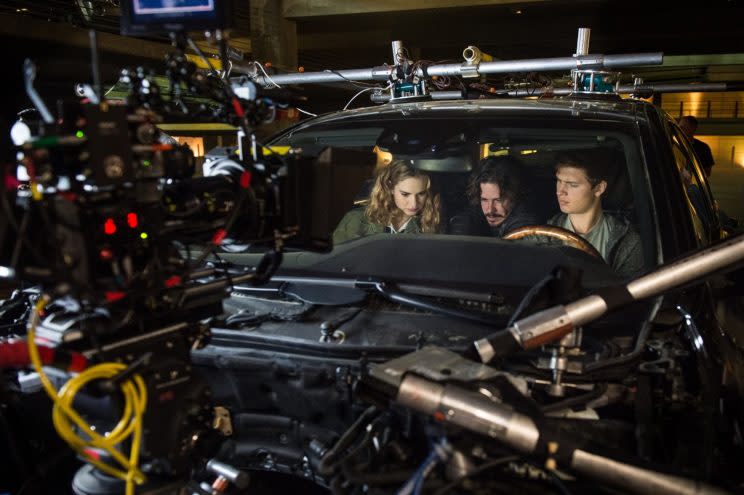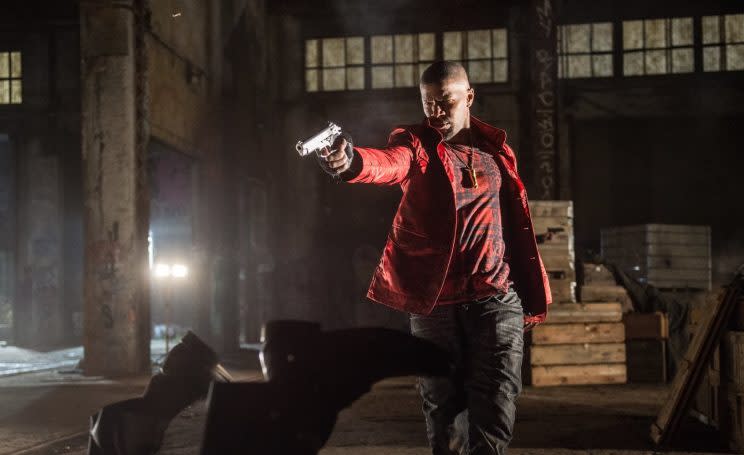Behind the 'Baby Driver' Music: How Edgar Wright Simultaneously Directed and DJ'ed New Hit Heist Film

Baby Driver is not a musical in the traditional sense. You won’t find any splashy song-and-dance numbers, even if the bold opening credits sequence teeters toward one when Ansel Elgort whimsically sashays down the sidewalk a la Travolta circa ’77. But Baby Driver just might make the case for establishing an entirely new musical subgenre.
“When I pitched it initially I called it a comedy driven by music,” writer-director Edgar Wright told Yahoo Movies shortly after the film — about a young getaway driver (Elgort) who combats an ever-present ringing in his ears by constantly bumping tunes in his ear buds — exceeded all expectations its first weekend at the U.S. box office.
It’s a comedy, sure. But it’s also a heist film. And it’s a romance. And maybe more so than we’ve ever seen executed on screen, it’s a DJ set — with Wright seamlessly dropping one carefully curated track after the next over the action from a 33-song collection that includes styles upon styles upon styles, from blues rock (Jon Spencer Blues Explosion) to breakbeats (Incredible Bongo Band), classic soul (Sam & Dave) to surf music (The Beach Boys), folk (Simon & Garfunkel) to funk (Kashmere Stage Band).
Baby Driver all started with the music. Wright (the Cornetto Trilogy, Scott Pilgrim), who took the concept for the film on a test drive with the 2003 music video for Mint Royale’s “Blue Song,” told us he “basically tried to write the film to the music.” Before the 43-year-old filmmaker had even outlined the story, he already had eight or nine tracks earmarked, like Focus’s “Hocus Pocus,” Bob & Earl’s “Harlem Shuffle,” and Queen’s “Brighton Rock.”

“Like a musical,” he explained, “those essentially became the big production numbers.” He foresaw Jon Spencer’s “Bellbottoms” driving the opening car chase, The Damned’s “Neat Neat Neat” fueling the second getaway, and The Button Down Brass’s “Tequila” comically countering the warehouse shootout.
By the time Wright finished the first draft of his script, he had 27 song targets in mind. Wright then hired a music editor named Steven Price — who in the 10 years since has gone on to become Steven Price, Oscar-winning composer of Gravity. “So what he did was help me break down these songs so I could figure them out,” Wright said. “I don’t read music and I don’t play an instrument, so I just needed somebody to help me break them down on the level of instrumentation and musical structure. He did, and then I incorporated a lot of that into the script.”
To pitch the project, Wright hired a DJ friend of his, Osymyso (né Mark Nicholson), to remix the tracks with sound effects to give potential producers and financiers a real feel for what the film would sound like. “So ‘Bellbottoms’ had all the car chase noises mixed into it and ‘Hocus Pocus’ had all the alarms and gunfire dubbed into it,” he remembered.
Of course, he still had to license everything, a process he didn’t dive into until summer 2014, “when we started seriously trying to make the movie.” It wasn’t a total coup. “There were some dance and hip-hop tracks where they were basically unclearable, it wasn’t a question. There were some songs where the artists themselves had not cleared the samples,” Wright said. “There were some hip-hop tracks that I just flat out couldn’t use.” There was another track the director wanted that included a sample from Star Wars. “I was like, ‘Oooh. Okay, forget it.’ ”
Wright is hardly the first filmmaker to write to music. It’s now bordering on becoming a “trend,” between Baby Driver and James Gunn‘s similar process on Marvel’s Guardians of the Galaxy movies. (Wright points to filmmakers like Martin Scorsese, Quentin Tarantino, and John Landis as the most influential purveyors of soundtracking.)

But what’s most impressive about Wright’s fusion of sound and film, apart from the sheer number of terrific music cues, is how he went about syncing the song over the action. It wasn’t done in the post-production process. The tracks were played live on set for the actors to respond to while filming.
“The editing [by Jonathan Amos and Paul Machliss] is incredible, but what people misunderstand is it isn’t made in the edits, the majority of it is choreographed to it on the day,” Wright explained. “We cleared the tracks, which means that the actors are listening to those tracks, which means that on the day we’re keeping track of how long the scene is and how it’s going to fit the song.”
So during the gunfight set to “Tequila,” Wright would be coordinating the dialogue and action beats to the music beats. When Baby meets Debora (Lily James) in the diner, Elgort was actually listening to the Beach Boys in his ear buds on set. “So it affects the tone of his performance, you know?” Wright said. It also gives the film its distinctly musical vibe.
Baby Driver is now in theaters. Watch our Facebook Live interview with Wright and cast:
Read more from Yahoo Movies:
